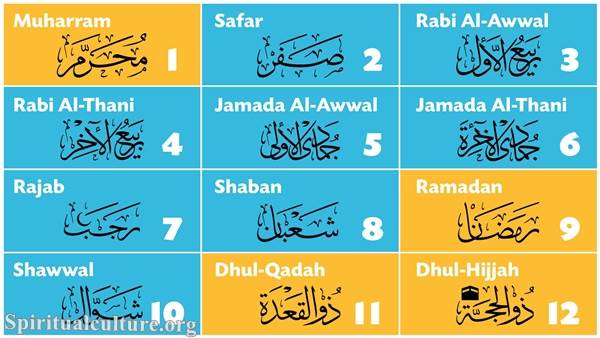Here are some additional details about the Islamic calendar:
– The Islamic calendar is based on the cycles of the moon, with each month beginning with the sighting of the new crescent moon. The months are named Muharram, Safar, Rabi’ al-awwal, Rabi’ al-thani, Jumada al-awwal, Jumada al-thani, Rajab, Sha’ban, Ramadan, Shawwal, Dhu al-Qi’dah, and Dhu al-Hijjah.
– The Islamic calendar is used in many Muslim countries, including Saudi Arabia, Iraq, and Iran, and is also used by Muslims worldwide to determine the dates of religious events and observances.
– The Islamic calendar has 12 months, but unlike the Gregorian calendar, its year is 10 to 11 days shorter. As a result, the Islamic calendar shifts forward by about 11 days each year in relation to the Gregorian calendar.
– Unlike the Gregorian calendar, the Islamic calendar does not have a fixed number of days in a week. The days of the week follow a seven-day cycle, with each day named after one of the seven celestial bodies known in classical astronomy: Sunday (Yawm al-ahad), Monday (Yawm al-ithnayn), Tuesday (Yawm ath-thalatha), Wednesday (Yawm al-arba’a), Thursday (Yawm al-khamis), Friday (Yawm al-jum’a), and Saturday (Yawm as-sabt).

– The Islamic calendar is an important part of Muslim identity, and its use is a symbol of religious and cultural continuity. The calendar is used to determine the dates of Islamic religious holidays, such as Eid al-Fitr, which marks the end of Ramadan, and Eid al-Adha, which celebrates the end of the annual pilgrimage to Mecca.
– The Islamic calendar is based on the lunar year, which is about 11 days shorter than the solar year used in the Gregorian calendar. To account for the difference, a leap year (known as a “hijri leap year”) is added to the Islamic calendar every 2 to 3 years, similar to the leap year in the Gregorian calendar.
– The Islamic calendar is used to determine the dates of important events in Islamic histories, such as the Hijra, which marks the Prophet Muhammad‘s migration from Mecca to Medina in 622 CE. This event is considered the starting point of the Islamic calendar and is used to calculate the Islamic era, or the “AH” (Anno Hijri) era.
The Islamic calendar has been widely used for religious purposes for centuries, but its use has also become an important part of secular and political life in many Muslim-majority countries. For example, the Islamic calendar is used as the official calendar in some countries, and it is used to determine the dates of official holidays, government transactions, and other important events.
The Islamic calendar is a key component of Muslim culture and tradition, and its use is an expression of cultural and religious identity for many Muslims around the world. Whether for religious observances or for secular purposes, the Islamic calendar continues to be an important part of the lives of many Muslims and is a symbol of their cultural and historical heritage.


